Effects of Climate Change on Navigability Indicators of the Lower Athabasca River, Canada
Abstract
1. Introduction
2. Study Area
3. Methods
3.1. Hydrometric Data Sources
3.2. Navigation Indices
3.2.1. Fall Aboriginal Navigation Index (ANIFall)
3.2.2. Percentage Days of Flow above a Threshold
3.3. Statistical Analyses
4. Results and Discussion
4.1. Historical Flow Thresholds
4.2. Historical Aboriginal Navigation Index
4.3. Climate Change Impacts on Future Navigation Thresholds
4.4. Climate Change Impacts on Future Aboriginal Navigation Index
5. Conclusions
Author Contributions
Funding
Data Availability Statement
Acknowledgments
Conflicts of Interest
Abbreviations
| List of Acronyms for Navigability Metrics | |
| ABF | Aboriginal Base Flow threshold (1600 m3 s−1) |
| ANI | Aboriginal Navigation Index (0 to 1 range) |
| ANIFall | Fall Aboriginal Navigation Index (0 to 1 range) |
| AXFO | Aboriginal Extreme Flow original threshold (400 m3 s−1) |
| AXFR | Aboriginal Extreme Flow revised threshold (500 m3 s−1) |
| INI | Indigenous Navigability Index |
| POT300 | Number of days in a week expressed as a percentage over threshold (POT) of 300 m3 s−1 |
| POT400 | Number of days in a week expressed as a percentage over threshold (POT) of 400 m3 s−1 |
| POT500 | Number of days in a week expressed as a percentage over threshold (POT) of 500 m3 s−1 |
| POT1600 | Number of days in a week expressed as a percentage over threshold (POT) of 1600 m3 s−1 |
References
- Cuo, L.; Zhang, Y.; Gao, Y.; Hao, Z.; Cairang, L. The Impacts of Climate Change and Land Cover/Use Transition on the Hydrology in the Upper Yellow River Basin, China. J. Hydrol. 2013, 502, 37–52. [Google Scholar] [CrossRef]
- Prowse, T.D.; Beltaos, S.; Gardner, J.T.; Gibson, J.J.; Granger, R.J.; Leconte, R.; Peters, D.L.; Pietroniro, A.; Romolo, L.A.; Toth, B. Climate Change, Flow Regulation and Land-Use Effects on the Hydrology of the Peace-Athabasca-Slave System; Findings from the Northern Rivers Ecosystem Initiative. Environ. Monit. Assess. 2006, 113, 167–197. [Google Scholar] [CrossRef]
- Wilcox, B.P.; Huang, Y.; Walker, J.W. Long-Term Trends in Streamflow from Semiarid Rangelands: Uncovering Drivers of Change. Glob. Chang. Biol. 2008, 14, 1676–1689. [Google Scholar] [CrossRef]
- Zarfl, C.; Lehner, B. European Rivers Are Fragmented by Many More Barriers than Had Been Recorded. Nature 2020, 588, 395–396. [Google Scholar] [CrossRef]
- Grill, G.; Lehner, B.; Lumsdon, A.E.; MacDonald, G.K.; Zarfl, C.; Liermann, C.R. An Index-Based Framework for Assessing Patterns and Trends in River Fragmentation and Flow Regulation by Global Dams at Multiple Scales. Environ. Res. Lett. 2015, 10, 015001. [Google Scholar] [CrossRef]
- Grill, G.; Lehner, B.; Thieme, M.; Geenen, B.; Tickner, D.; Antonelli, F.; Babu, S.; Borrelli, P.; Cheng, L.; Crochetiere, H.; et al. Mapping the World’s Free-Flowing Rivers. Nature 2019, 569, 215–221. [Google Scholar] [CrossRef]
- Ionita, M.; Nagavciuc, V. Forecasting Low Flow Conditions Months in Advance through Teleconnection Patterns, with a Special Focus on Summer 2018. Sci. Rep. 2020, 10, 13258. [Google Scholar] [CrossRef]
- Sung, R.Y.-J.; Burn, D.H.; Soulis, E.D. A Case Study of Climate Change Impacts on Navigation on the Mackenzie River. Can. Water Resour. J. 2006, 31, 57–68. [Google Scholar] [CrossRef]
- Woo, M.; Thorne, R. Summer Low Flow Events in the Mackenzie River System. Arctic 2016, 69, 286–304. [Google Scholar] [CrossRef]
- Whittaker, D.; Shelby, B.; Jackson, W.; Beschta, R.L. Instream Flows for Recreation: A Handbook on Concepts and Research Methods: A Handbook on Concepts and Research Methods; United States Department of the Interior National Park Service: Washington, DC, USA; Oregon State University: Corvallis, OR, USA, 1993; Available online: http://npshistory.com/publications/water/instream-flows.pdf (accessed on 11 March 2023).
- Rood, S.B.; George, C.; George, B.; Tymensen, W. Instream Flows for Recreation Are Closely Correlated with Mean Discharge for Rivers of Western North America. River Res. Appl. 2006, 22, 91–108. [Google Scholar] [CrossRef]
- Loomis, J.; McTernan, J. Economic Value of Instream Flow for Non-Commercial Whitewater Boating Using Recreation Demand and Contingent Valuation Methods. Environ. Manag. 2014, 53, 510–519. [Google Scholar] [CrossRef]
- Bonsal, B.; Peters, D.L.; Seglenieks, F.; Rivera, A.; Berg, A. Changes in Freshwater Availability across Canada. In Chapter 6 in Canada’s Changing Climate Report; Bush, E., Lemmen, D.S., Eds.; Government of Canada: Ottawa, ON, Canada, 2019; pp. 261–342. Available online: https://natural-resources.canada.ca/sites/www.nrcan.gc.ca/files/energy/Climate-change/pdf/CCCR-Chapter6-ChangesInFreshwaterAvailabilityAcrossCanada.pdf (accessed on 11 March 2023).
- DeBeer, C.M.; Wheater, H.S.; Pomeroy, J.W.; Barr, A.G.; Baltzer, J.L.; Johnstone, J.F.; Turetsky, M.R.; Stewart, R.E.; Hayashi, M.; van der Kamp, G.; et al. Summary and Synthesis of Changing Cold Regions Network (CCRN) Research in the Interior of Western Canada—Part 2: Future Change in Cryosphere, Vegetation, and Hydrology. Hydrol. Earth Syst. Sci. 2021, 25, 1849–1882. [Google Scholar] [CrossRef]
- Mannix, A.E.; Dridi, C.; Adamowicz, W.L. Water Availability in the Oil Sands under Projections of Increasing Demands and a Changing Climate: An Assessment of the Lower Athabasca Water Management Framework (Phase 1). Can. Water Resour. J. 2010, 35, 29–52. [Google Scholar] [CrossRef]
- Schindler, D.W.; Donahue, W.F. An Impending Water Crisis in Canada’s Western Prairie Provinces. Proc. Natl. Acad. Sci. USA 2006, 103, 7210–7216. [Google Scholar] [CrossRef]
- MCFN. Petition to the World Heritage Committee Requesting Inclusion of Wood Buffalo National Park on the List of World Heritage in Danger; Mikisew Cree First Nation Government & Industry Relations: Fort McMurray, AB, Canada, 2014; p. 43. Available online: https://cpawsnab.org/wp-content/uploads/2018/03/Mikisew_Petition_respecting_UNESCO_Site_256_-_December_8_2014.pdf (accessed on 11 March 2023).
- GoA. Surface Water Quantity Management Framework for the Lower Athabasca River; Alberta Environment and Sustainable Resource Development, Government of Alberta: Edmonton, AB, Canada, 2015; p. 80. Available online: https://open.alberta.ca/publications/9781460121733 (accessed on 11 March 2023).
- MCFN. Final Argument of the Mikisew Cree First Nation for the Hearing Regarding the Proposed Frontier Project; Canadian Environmental Assessment Agency: Ottawa, ON, Canada, 2018; p. 67. Available online: https://iaac-aeic.gc.ca/050/evaluations/document/126352 (accessed on 11 March 2023).
- Dillon Consulting. Athabasca River Navigation Study—Final Report Phases 3 and 4; Transport Canada: Ottawa, ON, Canada, 2019; p. 77. Available online: https://tc.canada.ca/en/marine/navigation-study-lower-athabasca-river (accessed on 11 March 2023).
- Peters, D.L.; Watt, D.; Devito, K.; Monk, W.A.; Shrestha, R.R.; Baird, D.J. Changes in Geographical Runoff Generation in Regions Affected by Climate and Resource Development: A Case Study of the Athabasca River. J. Hydrol. Reg. Stud. 2022, 39, 100981. [Google Scholar] [CrossRef]
- Downing, D.J.; Pettapiece, W.W. Natural Regions and Subregions of Alberta: Natural Regions Committee; Government of Alberta: Edmonton, AB, Canada, 2006; p. 852. Available online: https://www.albertaparks.ca/media/2942026/nrsrcomplete_may_06.pdf (accessed on 11 March 2023).
- NRBS. Northern Rivers Basins Study—Report to the Ministries 1996; Alberta Environmental Protection: Edmonton, AB, Canada, 1996; p. 287. Available online: https://www.ceaa.gc.ca/050/documents_staticpost/63919/96375/3-1996-Northern_River_Basins_Study-Report_to_the_Ministers.pdf (accessed on 11 March 2023).
- GOA Oil Sands Mine Reclamation and Disturbance Tracking by Year. Available online: https://osip.alberta.ca/library/Dataset/Details/27 (accessed on 2 February 2023).
- Newton, B.; Kashyap, S. 2019 Status of Surface Water Quantity—Lower Athabasca River Region; Government of Alberta; Alberta Environment and Parks: Edmonton, AB, Canada, 2021; p. 40. Available online: https://open.alberta.ca/publications/status-of-surface-water-quantity-lower-athabasca-region-alberta (accessed on 11 March 2023).
- AER Alberta Energy Regulator Oil Sands Water Use Data 2021. Available upon request: https://www.aer.ca/ (accessed on 21 March 2023).
- Kellerhals, R.; Neill, C.R.; Bray, D.I. Hydraulic and Geomorphic Characteristics of Rivers in Alberta; Alberta Cooperative Research Program in Highway and River Engineering: Edmonton, AB, Canada, 1972. [Google Scholar]
- Doyle, P.F. Hydrologic and Hydraulic Characteristics of the Athabasca River from Fort McMurray to Embarras; Alberta Research Council: Edmonton, AB, Canada, 1977; Available online: https://ags.aer.ca/publication/ofr-1977-13 (accessed on 11 March 2023).
- Peters, D.L.; Prowse, T.D. Generation of Streamflow to Seasonal High Waters in a Freshwater Delta, Northwestern Canada. Hydrol. Process. 2006, 20, 4173–4196. [Google Scholar] [CrossRef]
- Culp, J.; Droppo, I.; di Cenzo, P.; Alexander, A.; Baird, D.; Beltaos, S.; Bickerton, G.; Bonsal, B.; Brua, B.; Chambers, P.; et al. Synthesis Report for the Water Component, Canada-Alberta Joint Oil Sands Monitoring: Key Findings and Recommendations; 2018. Available online: https://open.alberta.ca/publications/9781460140253 (accessed on 11 March 2023).
- Culp, J.M.; Droppo, I.G.; di Cenzo, P.D.; Alexander, A.C.; Baird, D.J.; Beltaos, S.; Bickerton, G.; Bonsal, B.; Brua, R.B.; Chambers, P.A.; et al. Ecological Effects and Causal Synthesis of Oil Sands Activity Impacts on River Ecosystems: Water Synthesis Review. Environ. Rev. 2021, 29, 315–327. [Google Scholar] [CrossRef]
- JOSM. The Joint Canada|Alberta Implementation Plan for Oil Sands Monitoring Annual Report; Government of Canada: Ottawa, ON, Canada, 2012; p. 32. Available online: http://www.publications.gc.ca/site/eng/9.697128/publication.html (accessed on 11 March 2023).
- ECCC HYDAT Water Survey Data Products. Available online: https://www.canada.ca/en/environment-climate-change/services/water-overview/quantity/monitoring/survey/data-products-services.html (accessed on 21 February 2023).
- Dibike, Y.; Eum, H.-I.; Coulibaly, P.; Hartmann, J. Projected Changes in the Frequency of Peak Flows along the Athabasca River: Sensitivity of Results to Statistical Methods of Analysis. Climate 2019, 7, 88. [Google Scholar] [CrossRef]
- Taylor, K.E.; Stouffer, R.J.; Meehl, G.A. An Overview of CMIP5 and the Experiment Design. Bull. Am. Meteorol. Soc. 2012, 93, 485–498. [Google Scholar] [CrossRef]
- Eum, H.-I.; Dibike, Y.; Prowse, T. Climate-Induced Alteration of Hydrologic Indicators in the Athabasca River Basin, Alberta, Canada. J. Hydrol. 2017, 544, 327–342. [Google Scholar] [CrossRef]
- Eum, H.-I.; Dibike, Y.; Prowse, T. Comparative Evaluation of the Effects of Climate and Land-Cover Changes on Hydrologic Responses of the Muskeg River, Alberta, Canada. J. Hydrol. Reg. Stud. 2016, 8, 198–221. [Google Scholar] [CrossRef]
- Eum, H.-I.; Yonas, D.; Prowse, T. Uncertainty in Modelling the Hydrologic Responses of a Large Watershed: A Case Study of the Athabasca River Basin, Canada. Hydrol. Process. 2014, 28, 4272–4293. [Google Scholar] [CrossRef]
- Dibike, Y.; Eum, H.-I.; Prowse, T. Modelling the Athabasca Watershed Snow Response to a Changing Climate. J. Hydrol. Reg. Stud. 2018, 15, 134–148. [Google Scholar] [CrossRef]
- Candler, C.; Olson, R.; Deroy, S. As Long as the Rivers Flow: Athabasca River Knowledge, Use and Change; Parkland Institute: Edmonton, AB, Canada, 2010; p. 84. Available online: https://www.parklandinstitute.ca/as_long_as_the_rivers_flow (accessed on 11 March 2023).
- Carver, M. Indigenous Navigability of the Lower Athabasca River: Alberta’s SWQMF & Teck’s Effects Assessment—Submission to the Joint Review Panel for the Frontier Mine. Presented at the Joint Review Panel for the Frontier Oil Sands Mine. 2018. Available online: https://www.ceaa-acee.gc.ca (accessed on 11 March 2023).
- Carver, M.; Maclean, B. Community-Based Water-Depth Monitoring in the Peace-Athabasca Delta: Insights and Evaluation; Prepared by Aqua Environmental Associates for Athabasca Chipewyan First Nation and Mikisew Cree First Nation: Nelson, BC, Canada, 2016; Available online: http://mikisewgir.com/cbm (accessed on 11 March 2023)(upon request).
- Kashyap, S.; Kerkhoven, E.; Islam, Z.; Petty, A.; Depoe, S. Predicting Navigability in the Lower Athabasca River System Through Numerical Modelling. In Proceedings of the Canadian Society of Civil Engineering Annual Conference 2021; Walbridge, S., Nik-Bakht, M., Ng, K.T.W., Shome, M., Alam, M.S., El Damatty, A., Lovegrove, G., Eds.; Springer Nature: Singapore, 2022; pp. 479–490. [Google Scholar] [CrossRef]
- Kendall, M.G. Rank Correlation Methods; Charles Griffin: London, UK, 1975. [Google Scholar]
- Mann, H.B. Non-Parametric Test against Trend. Econometrika 1945, 13, 245–259. [Google Scholar] [CrossRef]
- R Development Core Team R: A Language and Environment for Statistical Computing. 2016. Available online: http://www.R-project.org (accessed on 21 March 2023).
- Bronaugh, D.; Werner, A.T. ZYP Package. 2019. Available online: https://cran.r-project.org/package=zyp/zyp.pdf (accessed on 21 March 2023).
- Zhang, X.; Zwiers, F.W. Comment on “Applicability of Prewhitening to Eliminate the Influence of Serial Correlation on the Mann-Kendall Test” by Sheng Yue and Chun Yuan Wang. Water Resour. Res. 2004, 40. [Google Scholar] [CrossRef]
- Bürger, G. On Trend Detection. Hydrol. Process. 2017, 31, 4039–4042. [Google Scholar] [CrossRef]
- Zhang, X.; Vincent, L.A.; Hogg, W.D.; Niitsoo, A. Temperature and Precipitation Trends in Canada during the 20th Century. Atmos.-Ocean. 2000, 38, 395–429. [Google Scholar] [CrossRef]
- Sen, P.K. Estimates of the Regression Coefficient Based on Kendall’s Tau. J. Am. Stat. Assoc. 1968, 63, 1379–1389. [Google Scholar] [CrossRef]
- Monk, W.A.; Peters, D.L.; Baird, D.J. Assessment of Ecologically Relevant Hydrological Variables Influencing a Cold-Region River and Its Delta: The Athabasca River and the Peace–Athabasca Delta, Northwestern Canada. Hydrol. Process. 2012, 26, 1827–1839. [Google Scholar] [CrossRef]
- Carver, M. Transport Canada Navigational Study of the Lower Athabasca River—Outcomes and Technical Review; Prepared by Aqua Environmental Associates for Athabasca Chipewyan First Nation and Mikisew Cree First Nation: Nelson, BC, Canada, 2020; Available online: https://registrydocumentsprd.blob.core.windows.net/commentsblob/project-80521/comment-54376/TC-nav-study_review-FINAL.pdf (accessed on 11 March 2023).
- Bawden, A.J.; Linton, H.C.; Burn, D.H.; Prowse, T.D. A Spatiotemporal Analysis of Hydrological Trends and Variability in the Athabasca River Region, Canada. J. Hydrol. 2014, 509, 333–342. [Google Scholar] [CrossRef]
- Peters, D.L. Multi-Scale Hydroclimatic Controls on the Duration of Water in Perched Wetlands of a Cold Regions Delta, Northwestern Canada; Environment Canada: Saskatoon, SK, Canada, 2013; p. 43. [Google Scholar]
- Peters, D.L.; Atkinson, D.; Monk, W.A.; Tenenbaum, D.E.; Baird, D.J. A Multi-Scale Hydroclimatic Analysis of Runoff Generation in the Athabasca River, Western Canada. Hydrol. Process. 2013, 27, 1915–1934. [Google Scholar] [CrossRef]
- Rasouli, K.; Hernández-Henríquez, M.A.; Déry, S.J. Streamflow Input to Lake Athabasca, Canada. Hydrol. Earth Syst. Sci. 2013, 17, 1681–1691. [Google Scholar] [CrossRef]
- Sauchyn, D.J.; St-Jacques, J.-M.; Luckman, B.H. Long-Term Reliability of the Athabasca River (Alberta, Canada) as the Water Source for Oil Sands Mining. Proc. Natl. Acad. Sci. USA 2015, 112, 12621–12626. [Google Scholar] [CrossRef]
- Rood, S.B.; Stupple, G.W.; Gill, K.M. Century-Long Records Reveal Slight, Ecoregion-Localized Changes in Athabasca River Flows. Hydrol. Process. 2015, 29, 805–816. [Google Scholar] [CrossRef]
- Chen, Z.; Grasby, S.E. Reconstructing River Discharge Trends from Climate Variables and Prediction of Future Trends. J. Hydrol. 2014, 511, 267–278. [Google Scholar] [CrossRef]
- Newton, B.; Kashyap, S. 2017 Status of Surface Water Quantity—Lower Athabasca River Region; Government of Alberta, Alberta Environment and Parks: Edmonton, AB, Canada, 2019; p. 27. Available online: https://open.alberta.ca/publications/status-of-surface-water-quantity-lower-athabasca-region-alberta (accessed on 11 March 2023).
- Newton, B. 2018 Status of Surface Water Quantity—Lower Athabasca River Region; Government of Alberta, Alberta Environment and Parks: Edmonton, AB, Canada, 2020; p. 33. Available online: https://open.alberta.ca/publications/status-of-surface-water-quantity-lower-athabasca-region-alberta (accessed on 11 March 2023).
- Newton, B.; Kashyap, S. 2020 Status of Surface Water Quantity—Lower Athabasca River Region; Government of Alberta, Alberta Environment and Parks: Edmonton, AB, Canada, 2022; p. 33. Available online: https://open.alberta.ca/publications/status-of-surface-water-quantity-lower-athabasca-region-alberta (accessed on 11 March 2023).
- Islam, Z.; Chantelle, L. 2015 and 2016 Status of Surface Water Quantity—Lower Athabasca River Region; Government of Alberta, Alberta Environment and Parks: Edmonton, AB, Canada, 2018; p. 25. Available online: https://open.alberta.ca/publications/status-of-surface-water-quantity-lower-athabasca-region-alberta (accessed on 11 March 2023).
- Bonsal, B.; Shrestha, R.R.; Dibike, Y.; Peters, D.L.; Spence, C.; Mudryk, L.; Yang, D. Western Canadian Freshwater Availability: Current and Future Vulnerabilities. Environ. Rev. 2020, 28, 528–545. [Google Scholar] [CrossRef]
- Leong, D.N.S.; Donner, S.D. Climate Change Impacts on Streamflow Availability for the Athabasca Oil Sands. Clim. Chang. 2015, 133, 651–663. [Google Scholar] [CrossRef]
- Rokaya, P.; Peters, D.L.; Elshamy, M.; Budhathoki, S.; Lindenschmidt, K.-E. Impacts of Future Climate on the Hydrology of a Northern Headwaters Basin and Its Implications for a Downstream Deltaic Ecosystem. Hydrol. Process. 2020, 34, 1630–1646. [Google Scholar] [CrossRef]
- Schnorbus, M.; Werner, A.; Bennett, K. Impacts of Climate Change in Three Hydrologic Regimes in British Columbia, Canada. Hydrol. Process. 2014, 28, 1170–1189. [Google Scholar] [CrossRef]
- Shrestha, R.R.; Schnorbus, M.A.; Peters, D.L. Assessment of a Hydrologic Model’s Reliability in Simulating Flow Regime Alterations in a Changing Climate. Hydrol. Process. 2016, 30, 2628–2643. [Google Scholar] [CrossRef]
- Shrestha, N.K.; Du, X.; Wang, J. Assessing Climate Change Impacts on Fresh Water Resources of the Athabasca River Basin, Canada. Sci. Total Environ. 2017, 601–602, 425–440. [Google Scholar] [CrossRef]
- Carver, M.; Maclean, B. Community-Based Monitoring of Water Depth in and around the Peace-Athabasca Delta: Ten-Year Review; Prepared by Aqua Environmental Associates for Athabasca Chipewyan First Nation and Mikisew Cree First Nation: Nelson, BC, Canada, 2022; p. 88. Available online: http://mikisewgir.com/cbm (accessed on 11 March 2023)(upon request).
- Wang, B.; Smith, L.C.; Gleason, C.J.; Kyzivat, E.D.; FAYNE, J.V.; Harlan, M.E.; Langhorst, T.; Feng, D.; Eidam, E.; Munoz, S.; et al. Athabasca River Avulsion Underway in the Peace-Athabasca Delta, Canada. Water Resour. Res. 2023, 59, e2022WR034114. [Google Scholar] [CrossRef]
- Richter, B.D.; Baumgartner, J.V.; Powell, J.; Braun, D.P. A Method for Assessing Hydrologic Alteration within Ecosystems. Conserv. Biol. 1996, 10, 1163–1174. [Google Scholar] [CrossRef]
- Peters, D.L.; Monk, W.A.; Baird, D.J. Cold-Regions Hydrological Indicators of Change (CHIC) for Ecological Flow Needs Assessment. Hydrol. Sci. J. 2014, 59, 502–516. [Google Scholar] [CrossRef]
- WBNP. Development of a Multi-Jurisdiction Action Plan to Protect the World Heritage Values of Wood Buffalo National Park; Parks Canada: Ottawa, ON, Canada, 2019; Available online: https://www.pc.gc.ca/en/pn-np/nt/woodbuffalo/info/action (accessed on 11 March 2023).
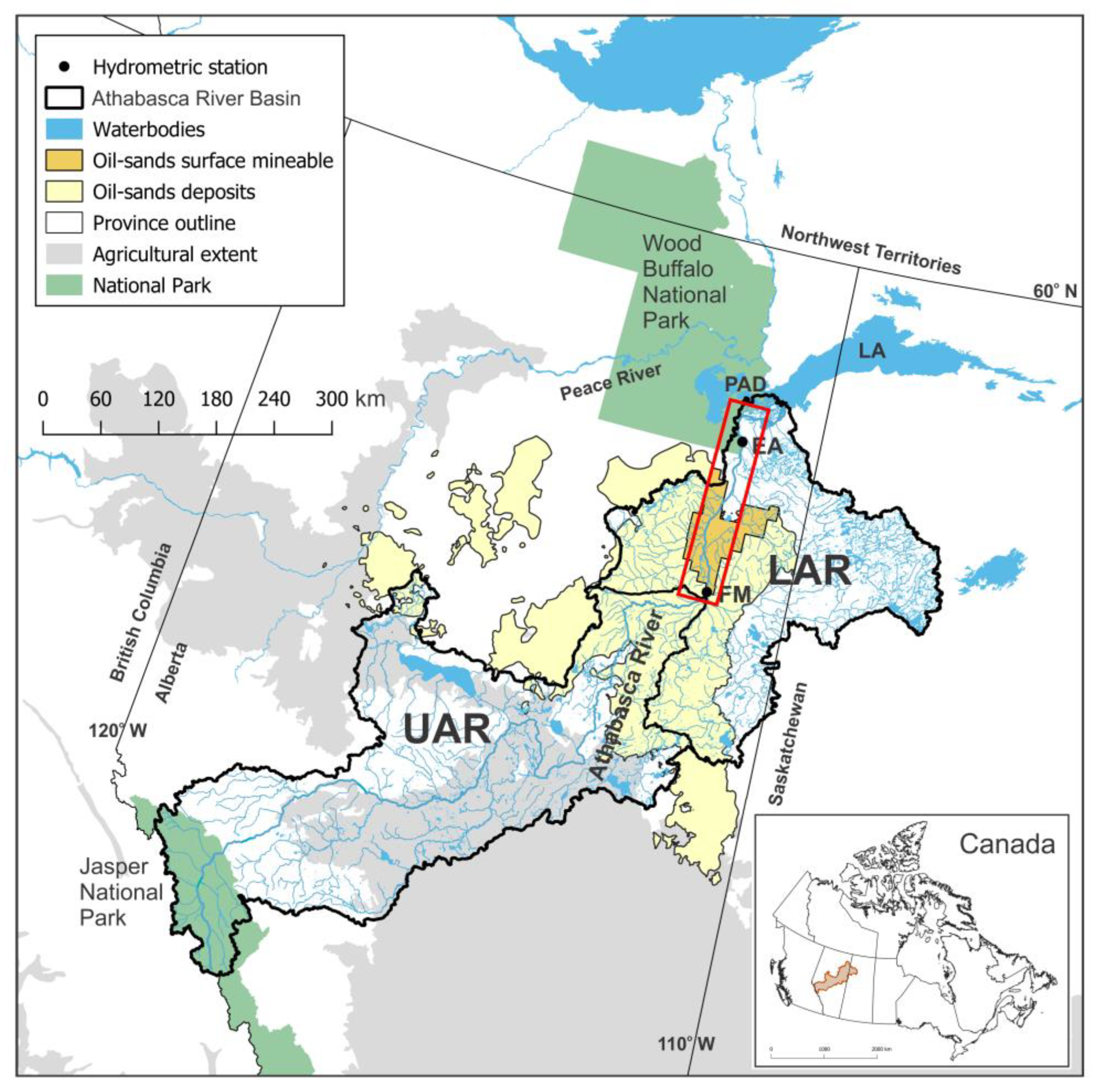
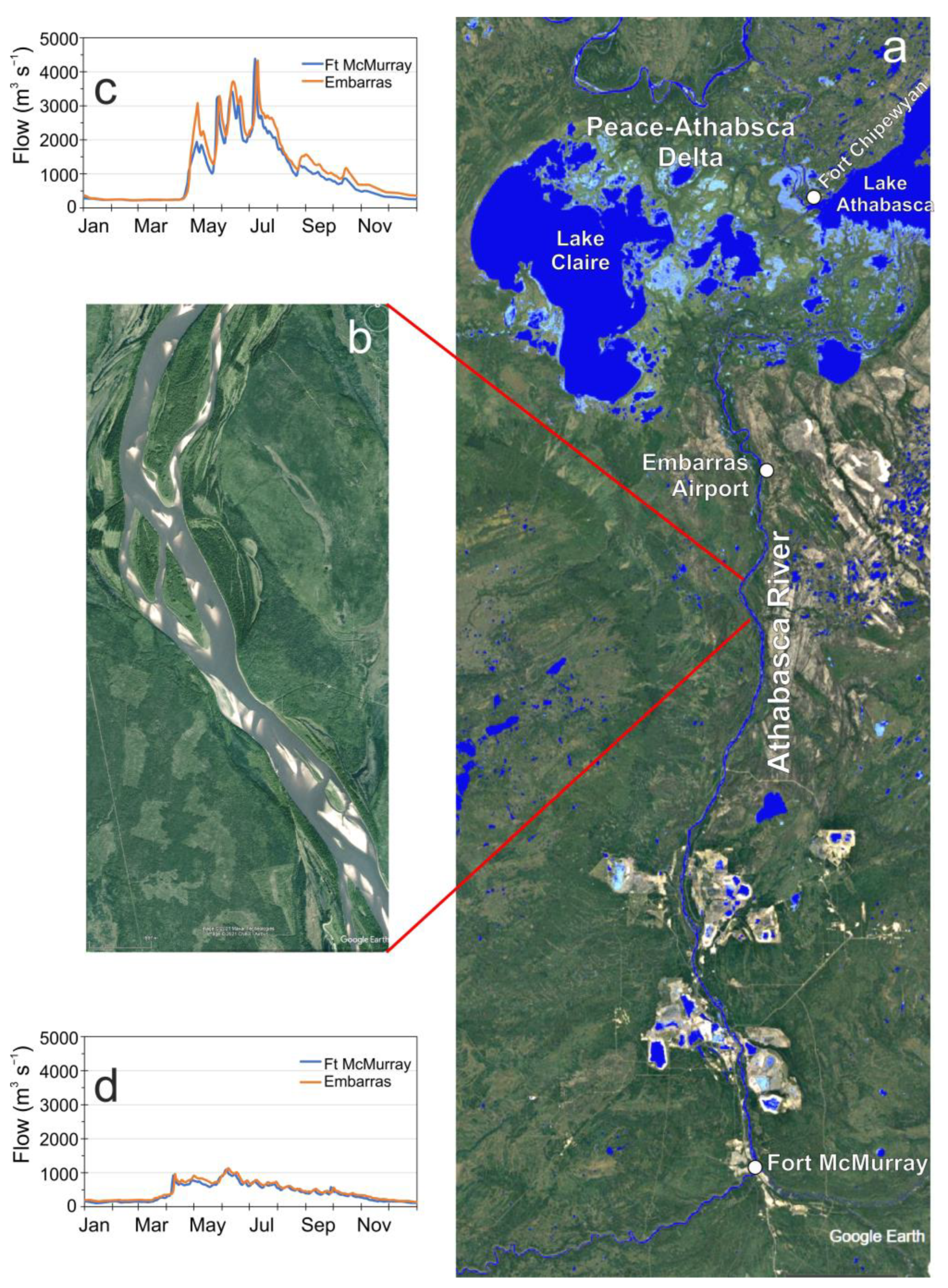
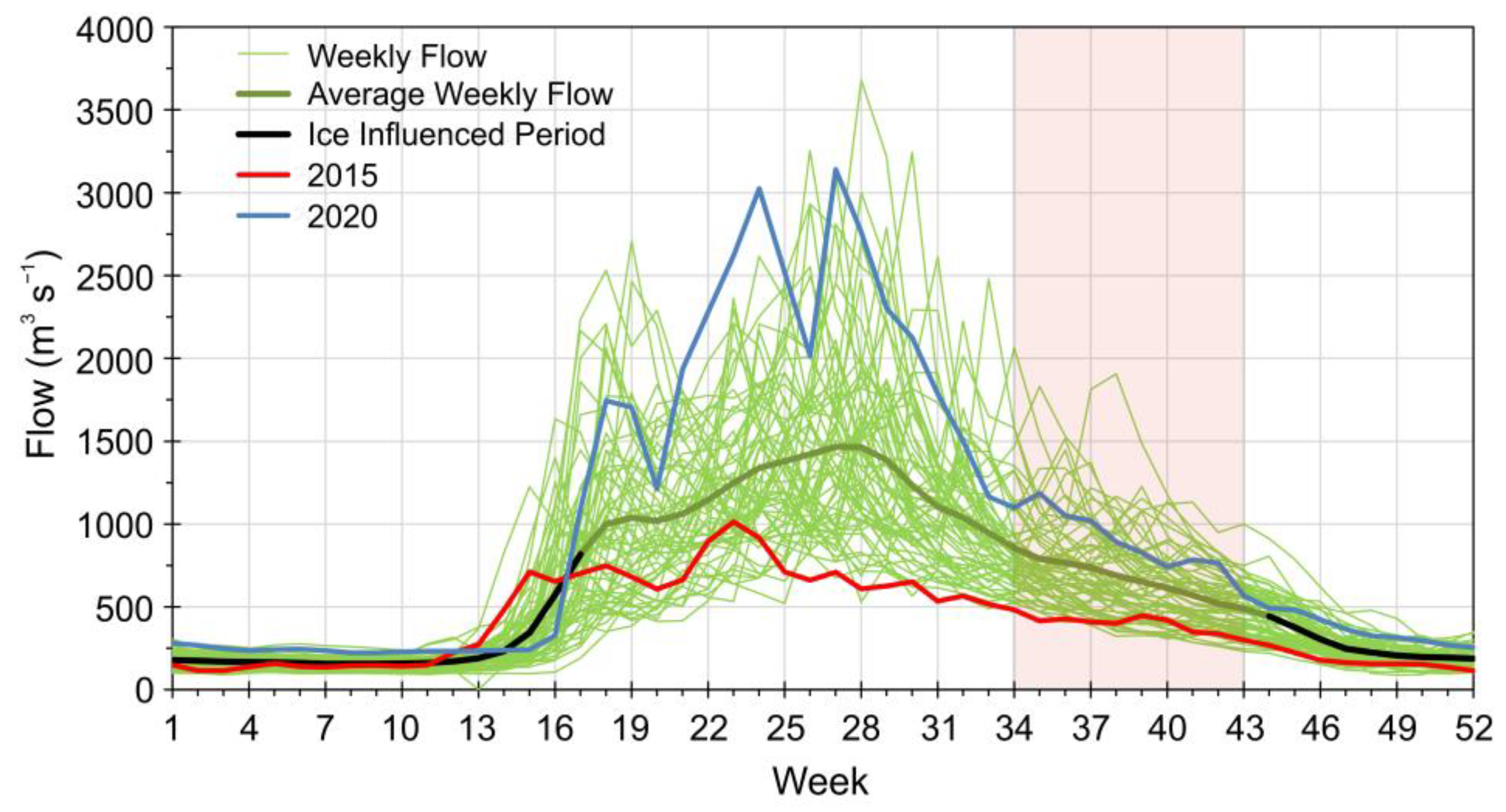
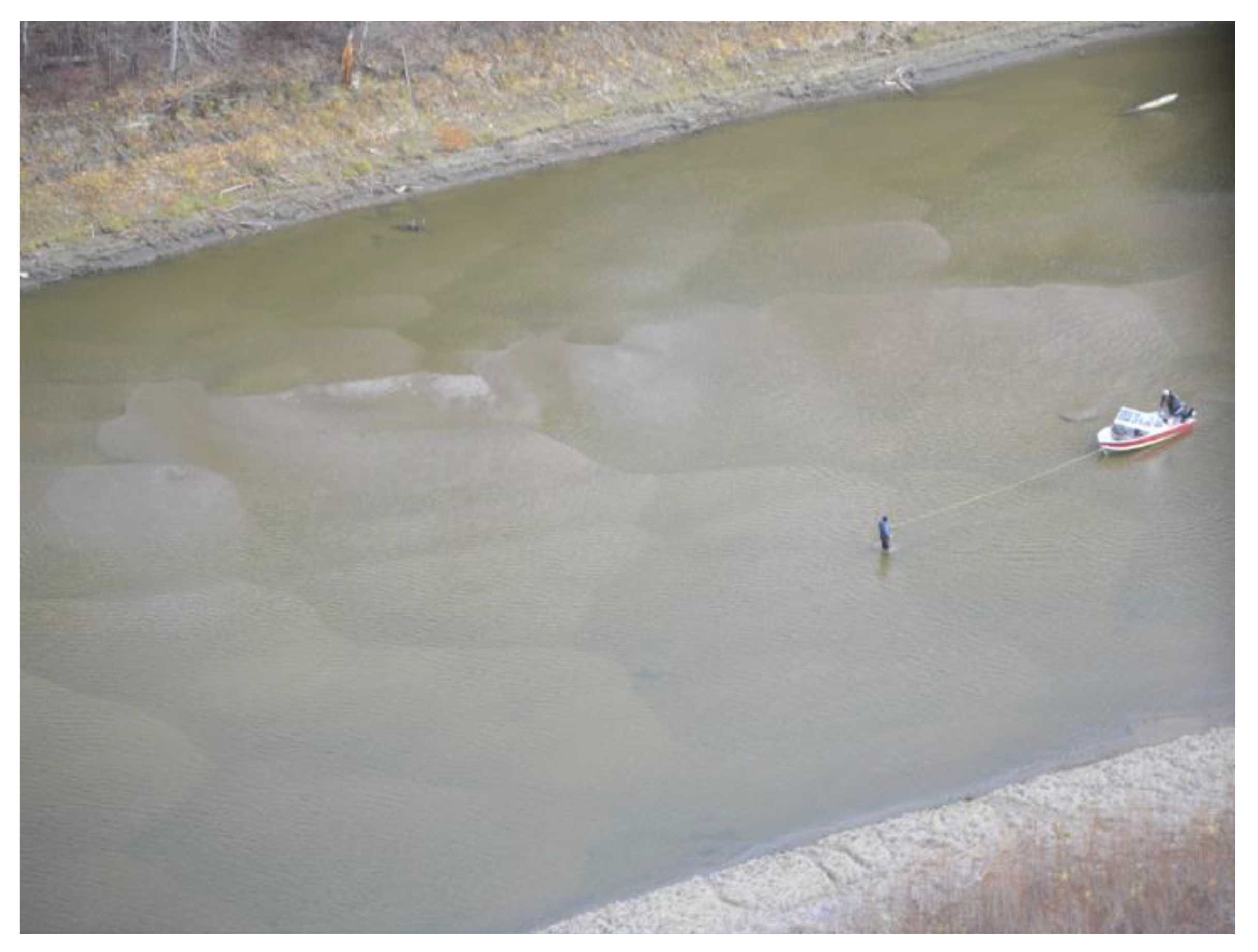
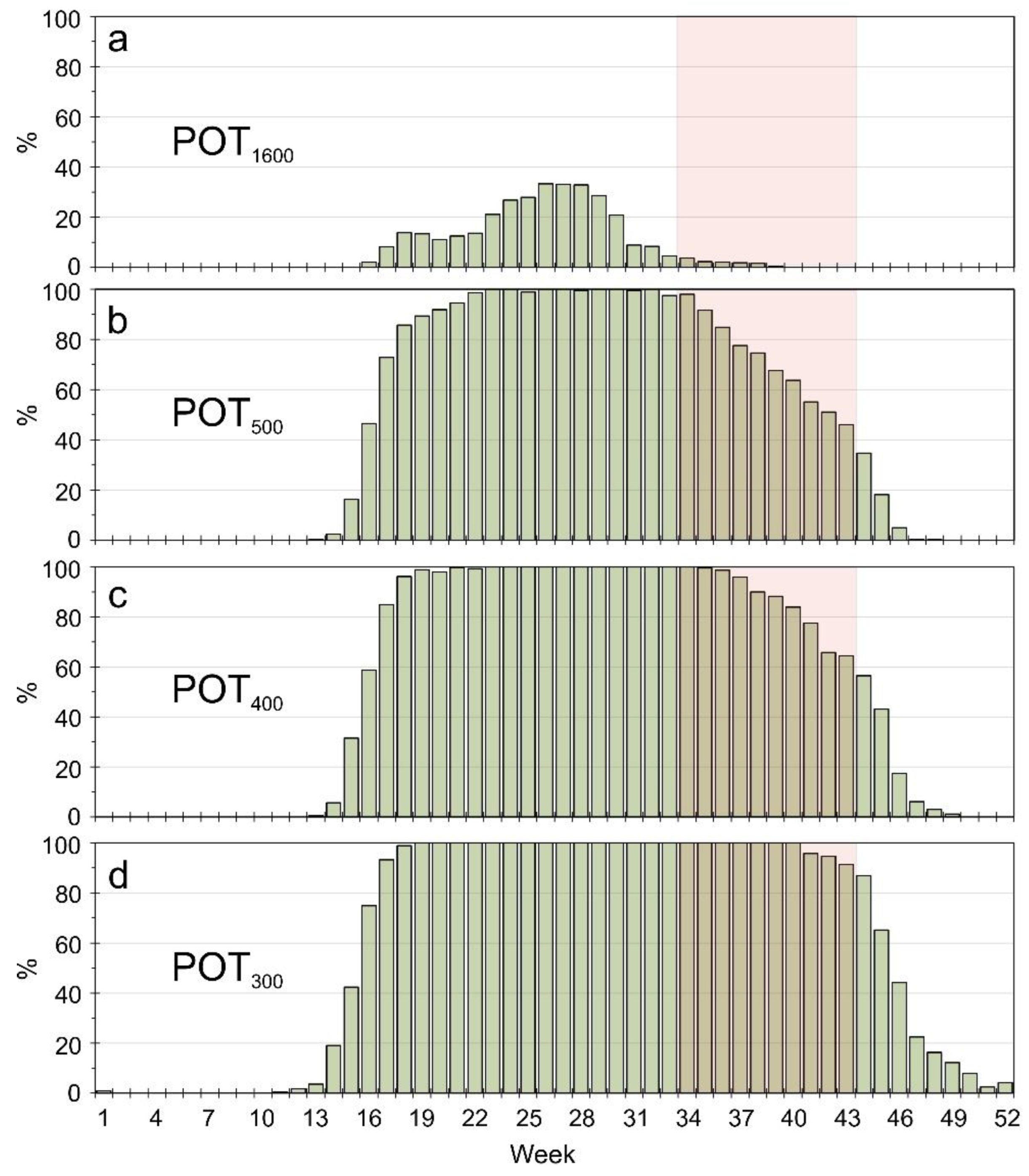
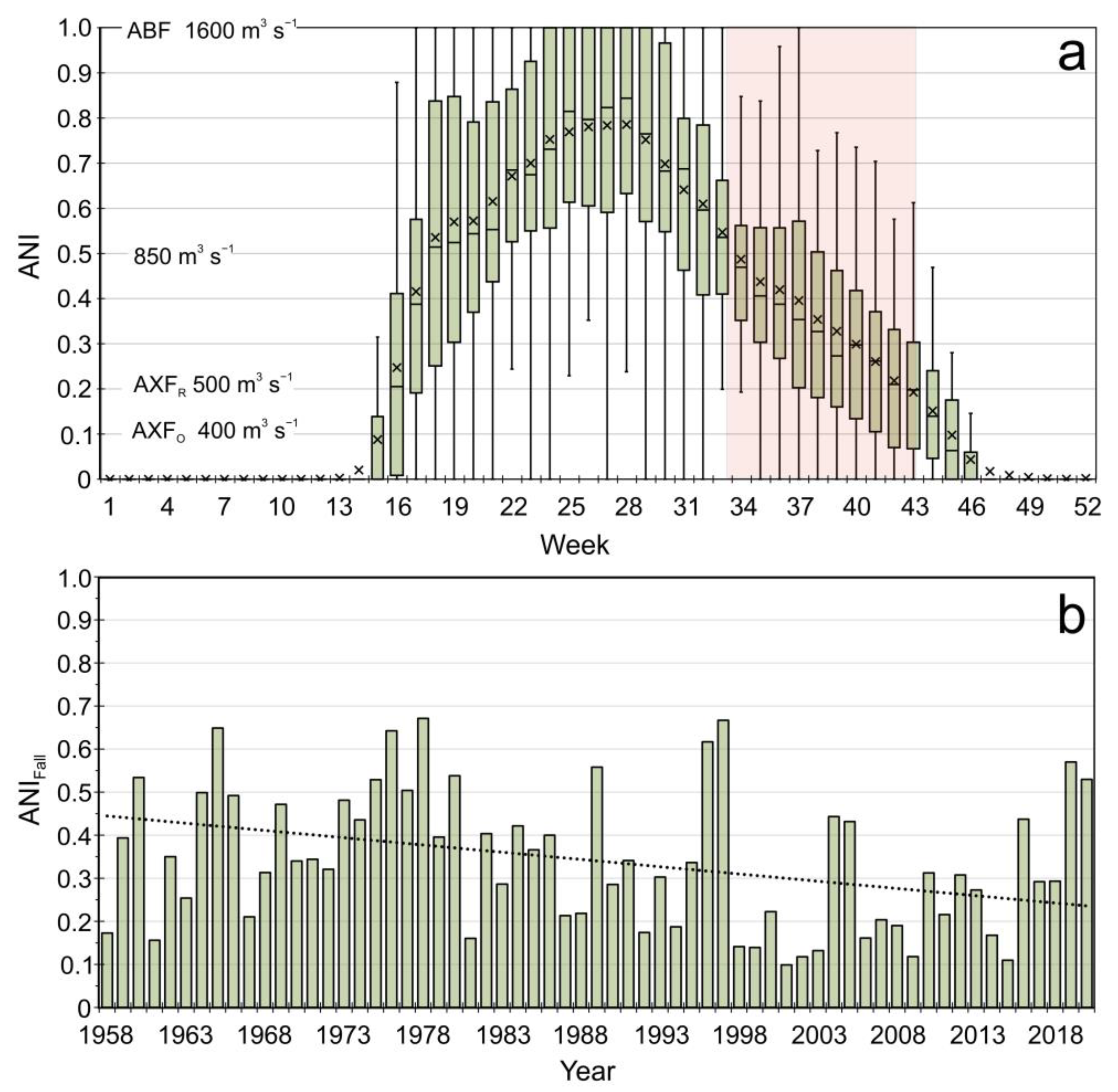

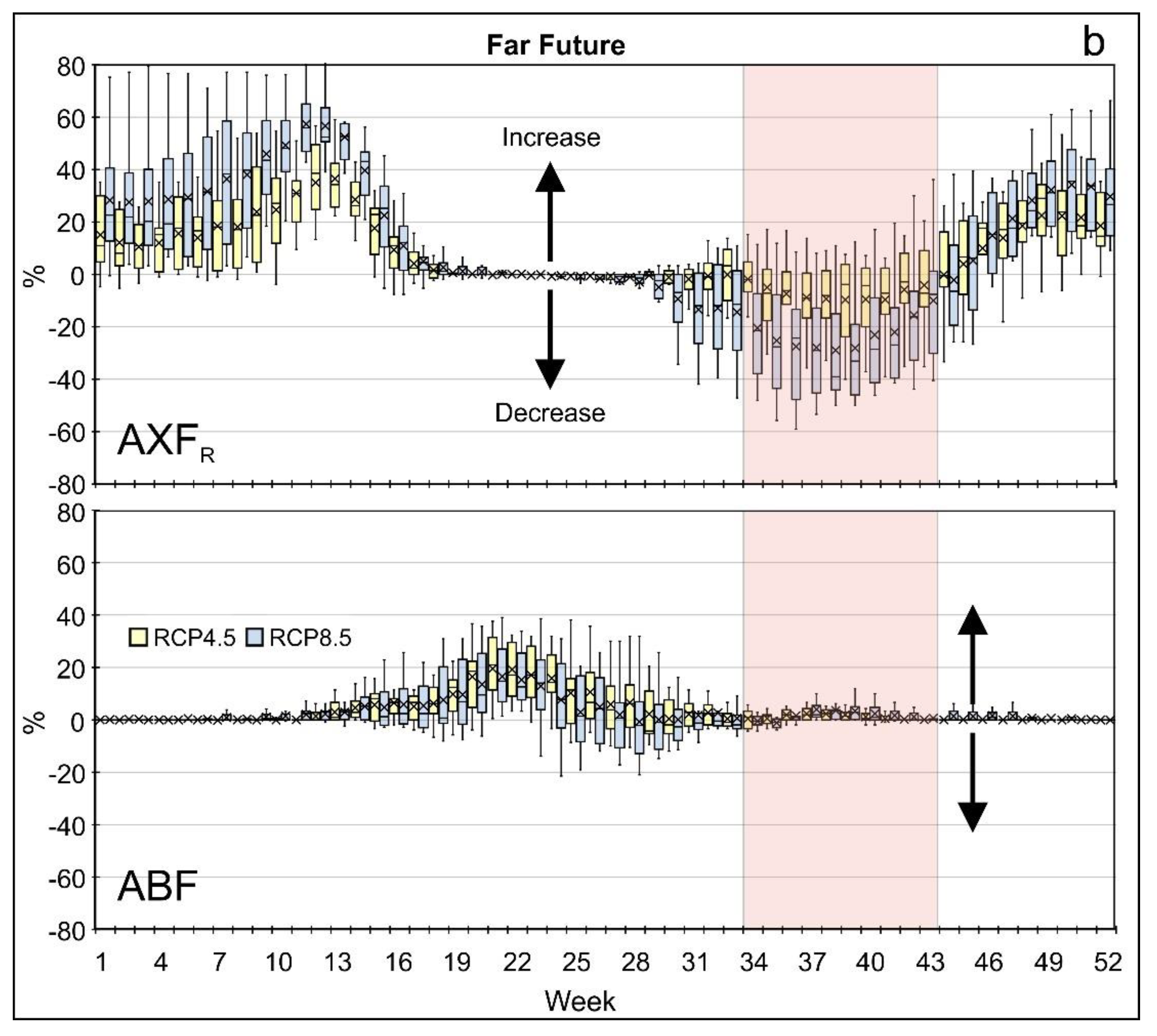


Disclaimer/Publisher’s Note: The statements, opinions and data contained in all publications are solely those of the individual author(s) and contributor(s) and not of MDPI and/or the editor(s). MDPI and/or the editor(s) disclaim responsibility for any injury to people or property resulting from any ideas, methods, instructions or products referred to in the content. |
© 2023 by the authors. Licensee MDPI, Basel, Switzerland. This article is an open access article distributed under the terms and conditions of the Creative Commons Attribution (CC BY) license (https://creativecommons.org/licenses/by/4.0/).
Share and Cite
Peters, D.L.; Dibike, Y.B.; Shudian, J.; Monk, W.A.; Baird, D.J. Effects of Climate Change on Navigability Indicators of the Lower Athabasca River, Canada. Water 2023, 15, 1373. https://doi.org/10.3390/w15071373
Peters DL, Dibike YB, Shudian J, Monk WA, Baird DJ. Effects of Climate Change on Navigability Indicators of the Lower Athabasca River, Canada. Water. 2023; 15(7):1373. https://doi.org/10.3390/w15071373
Chicago/Turabian StylePeters, Daniel L., Yonas B. Dibike, Joseph Shudian, Wendy A. Monk, and Donald J. Baird. 2023. "Effects of Climate Change on Navigability Indicators of the Lower Athabasca River, Canada" Water 15, no. 7: 1373. https://doi.org/10.3390/w15071373
APA StylePeters, D. L., Dibike, Y. B., Shudian, J., Monk, W. A., & Baird, D. J. (2023). Effects of Climate Change on Navigability Indicators of the Lower Athabasca River, Canada. Water, 15(7), 1373. https://doi.org/10.3390/w15071373







